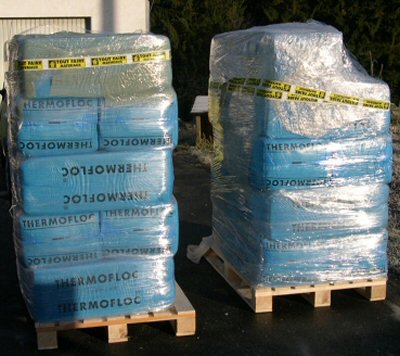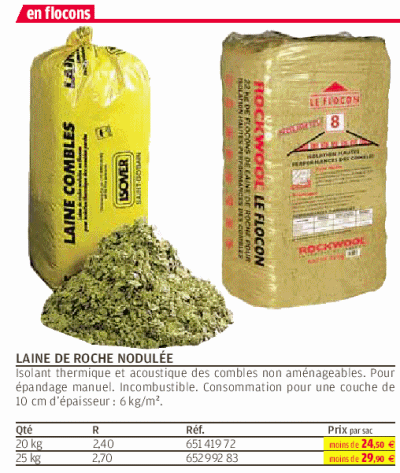Cellulose wadding used as insulation for lost attics: why this solution?
This winter we improved the insulation of our lost attics with loose cellulose wadding.
Obviously we wanted to use a natural insulation, this dossier aims to present this approach and answer the question: why and how have we improved the insulation of our attics with bulk cellulose? Here are some answers.

Why cellulose wadding?
La cellulose wadding seemed to us to be the best compromise for econological insulation for the following reasons:
- Excellent insulating properties
- Quite easily applicable by itself for lost roof spaces
- Moderate and very low price compared to other natural insulators
- Good behavior in time
- Very good comfort during the summer period (much greater thermal capacity than synthetic wools)
- This is recycled waste
- Easy to buy *
* In fact, currently in 2008, it is still very difficult to find certain other natural insulators delivered to you (at an attractive price, i.e. not 10 times the price of chemical insulators) although I regret a little that our cellulose comes from Austria but currently, this country seems to hold the European monopoly of the manufacture of cellulose insulation.
Straw would have been an even more ecological insulator because its impact is zero but we have ruled out this solution because its implementation is more delicate and especially finding it locally is almost impossible (it is obviously not produced industrially).
This choice of cellulose was not instantaneous since a fairly long reflection was carried out on our forums.
Thus, for all those interested in the subject for their project, you can read the subject natural insulation for lost roofs where many questions / answers are asked.
What thickness of wadding?
We wanted a thermal resistance R equivalent to the 2005 Thermal Regulation RT2005 is R = 6 to 6,5.
With a lambda of 0.04, we will therefore need to apply approximately 25cm of bulk cellulose thickness.
What price per m²? The natural, ecological, cheaper than the chemical!
We had to insulate 44 m² including an access hatch where it was obviously impossible to put cellulose in bulk. We therefore opted for a few m² of hemp wool panels and we made a small "formwork" as indicated on the page: bulk insulation, the preparation of the attic.
So here are the details of the bill for our insulation:
- 30 bags of 370L: 428.40 € is 11.1m3 or 38.59 € the m3
- 3 hemp wool panels 20 cm: 72.43 € for 2,07 m² is 174.15 € the m3
- Shipping and delivery: 86 €
TOTAL PRICE: 586.83 for 44 m ² approximately is 13.37 € the m² in R of 6,5!
A few comments:
- This cost is the delivered price but not posed (pose by ourselves)
- This price per m² is very reasonable, so contrary to what one might think, insulating “green” with cellulose is not expensive, quite the contrary!
- By taking 100% cellulose we would have had a cost of 10.20 € / m² for an 6,5 R
- By taking 100% hemp panels, on the other hand, we had a cost of 35.00 € / m² for an R of 5. Here we can speak of “ecological luxury”, so we used a minimum of hemp!
- A bonus / subsidy (not specific to the installation of natural insulation) can also be attributed to you. In our case, this premium from the Walloon Region amounts to around 160 €, which is far from being negligible.
- The delivery (not negotiable unfortunately) is a significant extra cost of 15%
- Bulk rock wool is more expensive than cellulose, see image (LM catalog) below: with equivalent thermal resistance, we get more than 20 € / m² for loose rock wool!

Suite of this folder insulation
- Receipt of insulation materials
- The preparation of the attic
- The laying of cellulose
- Video explaining how to lay cellulose
More: cost of cellulose and comparison with synthetic wool in bulk and table comparative insulation

